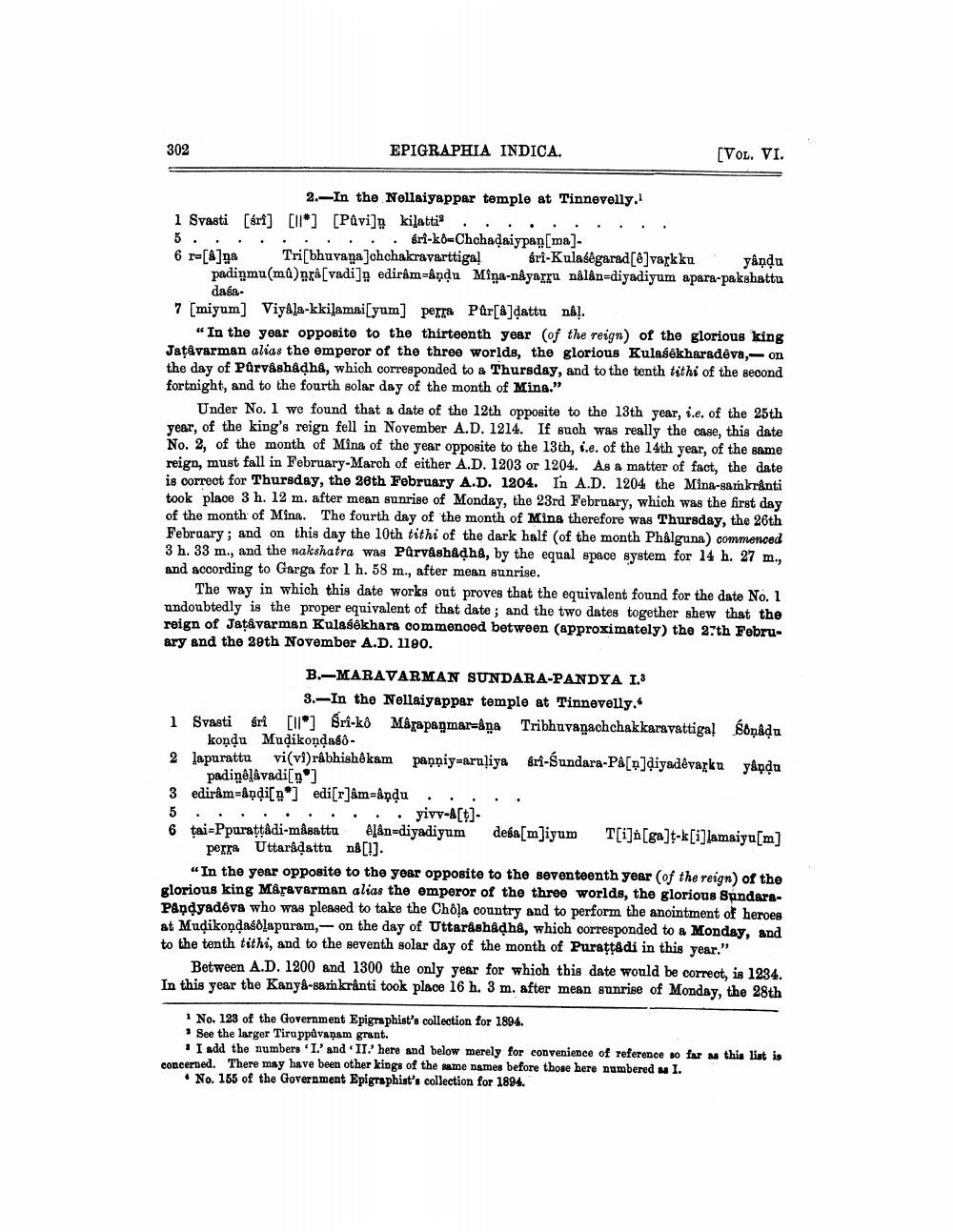________________
302
EPIGRAPHIA INDICA.
(VOL. VI.
2.-In the Nellaiyappar temple at Tinnevelly. 1 Svasti [óri] [11*] [Pavi]n kisatti 5. . . . . . . . . . Sri-k8=Chohadaiypan[ma] 6 r-[]na Tri[bhuvaņa]chchakravarttiga! sri-Kulasegarad[@]varkku . yându
padiņmu(mů prâ[vadi], edirâm=&ņdu Miņa-nâyarru nål&n=diyadiyum apara-pakshattu
daśa. 7 [miyum] Viyala-kkiļamai[yum] perra Par[a]dattu nk!.
“In the year opposite to the thirteenth year of the reign) of the glorious king Jaţävarman alias the emperor of the three worlds, the glorious Kulasekharadêva, - on the day of Porv&shadha, which corresponded to a Thursday, and to the tenth tithi of the second fortnight, and to the fourth solar day of the month of Mina."
Under No. 1 we found that a date of the 12th opposite to the 13th year, i.e. of the 25th year, of the king's reign fell in November A.D. 1214. If such was really the case, this date No. 2, of the month of Mina of the year opposite to the 13th, s.e. of the 14th year, of the same reign, must fall in February March of either A.D. 1203 or 1204. As a matter of fact, the date is correct for Thursday, the 28th February A.D. 1204. In A.D. 1204 the Mina-samkrånti took place 3 h. 12 m. after mean sunrise of Monday, the 23rd February, which was the first day of the month of Mina. The fourth day of the month of Ming therefore was Thursday, the 26th February; and on this day the 10th tithi of the dark half of the month Phålguna) commenced 3 h. 33 m., and the nakshatra was Pârvashidha, by the equal space system for 14 h. 27 m., and according to Garga for 1 h. 58 m., after mean sunrise.
The way in which this date works ont proves that the equivalent found for the date No. 1 andoubtedly is the proper equivalent of that date; and the two dates together shew that the reign of Jatavarman Kulasekhara commenced between (approximately) the 27th February and the 29th November A.D. 1190.
B-MARAVARMAN SUNDARA-PANDYA I.
3.- In the Nellaiyappar temple at Tinnevelly.. 1 Svasti Sri [lit] Sri-kổ Mârapagmar=&ņa Tribhuvanachchakkaravattiga! soņâdu
kondu Mudikondago2 lapurattu vi(vi)rabhish&kam paņņiy-aruliya Sri-Sundara-Pa[n]diyadêvarku yandı
padiņělávadi[9] 3 edir&m=åņdico'] edi[r]ám=&ņdu ..... 5 . . . . . . . . . . yivv-A[t]6 tai=Ppurattádi-måsatta @fân=diyadiyum deba[m]iyum T[i]n[ga]t-k[i]lamaiyu[m]
porra Uttaradattu ng[].
“In the year opposite to the year opposite to the seventeenth year of the reign of the glorious king Måravarman alias the emperor of the three worlds, the glorious SundarsPandyadeva who was pleased to take the Chola country and to perform the anointment of heroes at Mudikondasolapuram,- on the day of Uttarashadha, which corresponded to a Monday, and to the tenth tithi, and to the seventh solar day of the month of Puratt&di in this year."
Between A.D. 1200 and 1300 the only year for which this date would be correct. is 1234. In this year the Kanya-sankranti took place 16 h. 3 m. after mean sunrise of Monday, the 28th
No. 123 of the Government Epigraphist's collection for 1894. * See the larger Tiruppavanam grant.
1 I add the numbers T.' and II. here and below merely for convenience of reference so far as this list is concerned. There may have been other kings of the same names before those here numbered a I.
• No. 155 of the Government Epigraphist's collection for 1894.




